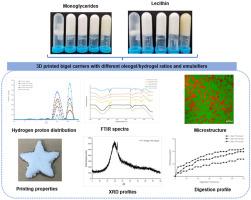Influence of oleogel/hydrogel ratios and emulsifiers on structural and digestion properties of food-grade 3D printed bigels as carriers for quercetin and catechin
Abstract
Bigels are system with great potential in 3D printing and bioactive compound delivery. In this study, 3D printed bigels based on candelilla wax oleogel and gelatin hydrogel were developed as delivery system for hydrophilic and lipophilic bioactives (namely, quercetin and catechin). Bigels with monoglyceride or lecithin formed stable gel system with 3D printing ability. Microstructural study found that changing of oleogel/hydrogel ratios (3:7, 5:5, and 7:3) under the presence of different emulsifiers (monoglyceride and lecithin) led to structural transformation of bigels from oleogel-in-hydrogel structure to hydrogel-in-oleogel or bicontinuous status. Low frequency-NMR analysis indicated that the signals of typical T2 relaxation peak were changed accordingly with variations of oleogel/hydrogel ratio and using of different emulsifiers. XRD patterns of bigels revealed their crystalline peaks grew with increase of oleogel content. In vitro digestion study found that both oleogel/hydrogel ratio and emulsifiers used exhibited large influence on the lipolysis extent, release rate of quercetin and catechin from bigels. The highest release rate for catechin (53.37%) and quercetin (11.08%) were observed in bigels containing monoglyceride with 70% oleogel and lecithin with 30% oleogel after simulated digestion, respectively. This study provided valuable guidance for developing bigels as 3D printed food with potential in co-delivery of hydrophilic and lipophilic bioactives by adjusting oleogel/hydrogel ratios and emulsifiers used.


 求助内容:
求助内容: 应助结果提醒方式:
应助结果提醒方式:


